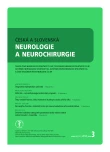Spinal Shock – from Pathophysiology to Clinical Manifestation
Authors:
R. Háková 1; J. Kříž 1,2
Authors‘ workplace:
Spinální jednotka při Klinice RHB a TVL 2. LF UK a FN v Motole, Praha
1; Ortopedicko-traumatologická klinika 3. LF UK a FN Královské Vinohrady, Praha
2
Published in:
Cesk Slov Neurol N 2015; 78/111(3): 263-267
Category:
Review Article
doi:
https://doi.org/10.14735/amcsnn2015263
Overview
Spinal shock occurs as a consequence of an abrupt interruption of descending supraspinal pathways. The term spinal shock describes a phenomenon when a trauma, ischemia, hemorrhage or inflammation results in sudden loss of neurological functions below the level of the injury. Clinically, transient loss or decrease of reflex activity below the level of the injury, hypotonia and disturbance of motor, sensory and autonomic functions predominate. In order to clarify the mechanism behind the spinal shock and subsequent return of reflex activity or even hyperreflexia, we need to understand the changes taking place in motor neurons below the level of the injury. These changes consist of three main phases. Reduction of reflex activity results from decreased excitability of spinal motor neurons. Resumption of reflex activity or voluntary movement is attributed to denervation hypersensitivity and hyperreflexia occurs due to new synaptic growth. Consequently, the motor neuron below the level of injury is predominantly under either voluntary or reflex control. As a result, various levels of spasticity develop or, in case of an incomplete lesion, voluntary movement might be recovered, depending on the extent of spinal cord injury.
Key words:
spinal shock – spinal cord injury – tetraplegia – paraplegia – synapse – spasticity
The authors declare they have no potential conflicts of interest concerning drugs, products, or services used in the study.
The Editorial Board declares that the manuscript met the ICMJE “uniform requirements” for biomedical papers.
Sources
1. Atkinson PP, Atkinson JL. Spinal shock. Mayo Clin Proc 1996; 71(4): 384– 389.
2. Štětkářová I. Mechanizmy spasticity a její hodnocení. Cesk Slov Neurol N 2013; 76/ 109(3): 267– 280.
3. Grigorean VT, Sandu AM, Popescu M, Iacobini MA, Stoian R, Neascu C et al. Cardiac dysfunctions following spinal cord injury. J Med Life 2009; 2(2): 133– 145.
4. Ditunno JF, Little JW, Tessler A, Burns AS. Spinal shock revisited: a four‑ phase model. Spinal Cord 2004; 42: 383– 395.
5. Nacimiento W, Noth J. What, if Anything, is Spinal Shock. Arch Neurol 1999; 56(8): 1033– 1035.
6. Guttmann L. The Stoke Mandeville National Spinal Injuries Centre. In: Guttmann L (ed). Spinal Cord Injuries, Comprehensive Management and Research. Oxford, England: Blackwell Scientific Publication 1976.
7. Little JW, Ditunno JF jr, Stiens SA, Harris RM. Incomplete spinal cord injury: neuronal mechanisms of motor recovery and hyperreflexia. Arch Phys Med Rehabil 1999; 80(5): 587– 599.
8. Smith PM, Jeffery ND. Spinal shock – comparative aspects and clinical relevance. J Vet Intern Med 2005; 19(6): 788– 793.
9. Leis AA, Kronenberg MF, Štětkářová I, Paske WC, Stokić DS. Spinal motoneuron excitability after acute spinal cord injury in humans. Neurology 1996; 47: 231– 237.
10. Boland RA, Lin CS, Engel S, Kiernan MC. Adaptation of motor function after spinal cord injury: novel insights into spinal shock. Brain 2011; 134(2): 495– 505. doi: 10.1093/ brain/ awq289.
11. Simpson RK jr, Robertson CS, Goodman JC. The role of glycine in spinal shock. J Spinal Cord Med 1996; 19(4): 215– 224.
12. Hiersemenzel LP1, Curt A, Dietz V. From spinal shock to spasticity: neuronal adaptations to a spinal cord injury. Neurology 2000; 54(8): 1574– 1582.
13. Ko HY, Ditunno JF jr, Graziani V, Little JW. The pattern of reflex recovery during spinal shock. Spinal Cord 1999; 37(6): 402– 409.
14. Kříž J, Háková R, Hyšperská V, Hlinková Z, Lukáš R, Andel R. Mezinárodní standardy pro neurologickou klasifikaci míšního poranění – revize 2013. Cesk Slov Neurol N 2014; 77/ 110(1): 77– 81.
15. Krassioukov AV, Karlsson AK, Wecht JM, Wuermser LA,Mathias CJ, Mathias CJ et al. Assessment of autonomic dysfunction following spinal cord injury: rationale for additions to International Standards for Neurological Assessment. J Rehabil Res 2007; 44(1): 103– 112.
16. Guly HR, Bouamra O, Lecky FE. The incidence of neurogenic shock in patients with isolated spinal cord injury in the emergency department. Resuscitation 2008; 76(1): 57– 62.
17. Weinstein DE, Ko HY, Graziani V, Ditunno JF jr. Prognostic significance of the delayed plantar reflex following spinal cord injury. J Spinal Cord Med 1997; 20(2): 207– 211.
18. Nielsen J, Crone C, Hultborn H. H‑ reflexes are smaller in dancers from The Royal Danish Ballet than in welltrained athletes. Eur J Appl Physiol Occup Physiol 1993; 66(2): 116– 121.
19. Kříž J, Rejchrt M. Autonomní dysreflexie – závažná komplikace u pacientů po poranění míchy. Cesk Slov Neurol N 2014; 77/ 110(2): 168– 173.
20. Silver JR. Early autonomic dysreflexia. Spinal Cord 2000; 38: 229– 233.
21. Weaver LC, Fleming JC, Mathias CJ, Krassioukov AV. Disordered cardiovascular control after spinal cord injury. Handb Clin Neurol 2012; 109: 213– 233. doi: 10.1016/ B978‑ 0‑ 444‑ 52137‑ 8.00013‑ 9.
22. Little JW, Halar E. Temporal Course of Motor Recovery after Brown‑ Sequard Spinal Cord Injuries. Paraplegie 1985; 23(1): 39– 46.
Labels
Paediatric neurology Neurosurgery NeurologyArticle was published in
Czech and Slovak Neurology and Neurosurgery

2015 Issue 3
Most read in this issue
- Addenbrooke’s Cognitive Examination – Approximate Normal Values for the Czech Population
- Spinal Shock – from Pathophysiology to Clinical Manifestation
- Diagnosis of Epileptic Seizures
- Air Embolism of the Brain – a Case Report
